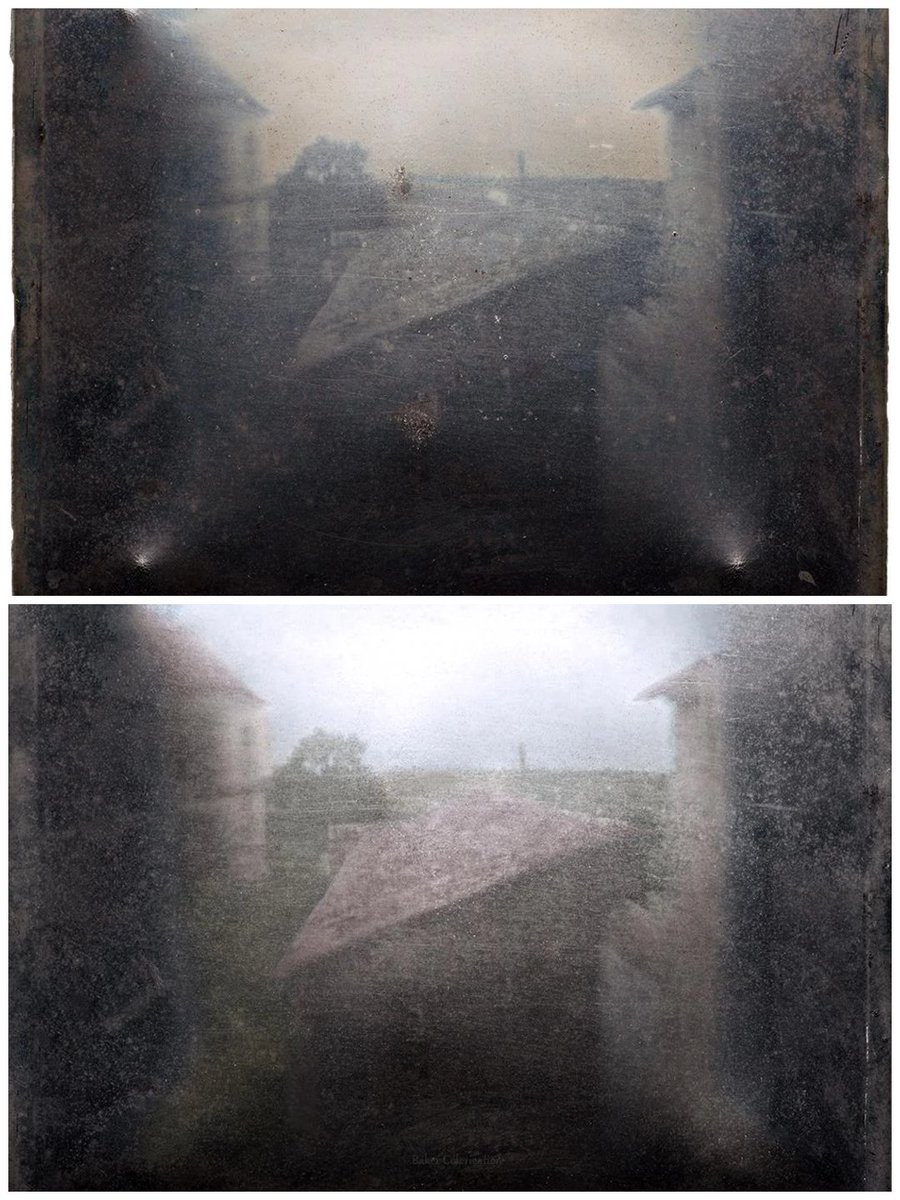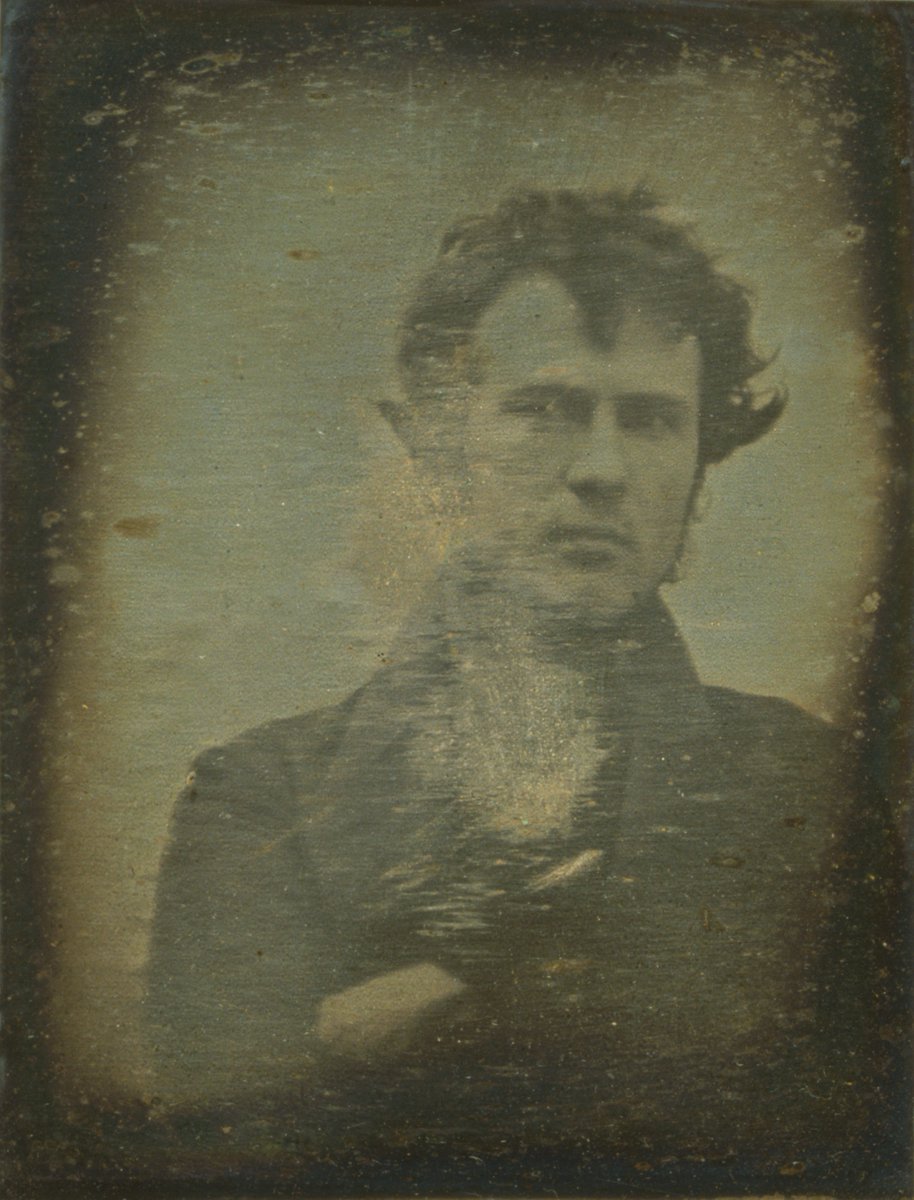Robert Cornelius' 1839 daguerreotype - the first publicly available photographic process - is widely accepted as the first known photographic self-portrait of a person ever taken. 

2. The first photo ever taken, 1826
"View from the Window at Le Gras" by French inventor Nicéphore Niépce is the oldest surviving camera photograph. The picture shows the buildings and surrounding countryside of his estate, Le Gras, as seen from a window.
"View from the Window at Le Gras" by French inventor Nicéphore Niépce is the oldest surviving camera photograph. The picture shows the buildings and surrounding countryside of his estate, Le Gras, as seen from a window.

3. The first photo with people, 1838
This photograph by Louis Daguerre depicts Place de la République, Paris, with two human figures in the left-hand corner.
It is the world’s first photograph of the "Ville Lumière" and the first photo with humans.
This photograph by Louis Daguerre depicts Place de la République, Paris, with two human figures in the left-hand corner.
It is the world’s first photograph of the "Ville Lumière" and the first photo with humans.

4. The first photo of a President, 1843
This portrait of John Quincy Adams, taken at his home in Quincy, Massachusetts, is the oldest existing photo of a U.S. president. The very first photograph of a president (William Henry Harrison) was taken in 1841 but has now been lost.
This portrait of John Quincy Adams, taken at his home in Quincy, Massachusetts, is the oldest existing photo of a U.S. president. The very first photograph of a president (William Henry Harrison) was taken in 1841 but has now been lost.

5. The first photo of war, 1870
Carol Szathmari, the first known war photographer, captured the very first photograph of an actual battle. Showing a line of Prussian troops as they advance, the photographer shot the image as he stood with French defenders.
Carol Szathmari, the first known war photographer, captured the very first photograph of an actual battle. Showing a line of Prussian troops as they advance, the photographer shot the image as he stood with French defenders.

6. The first color photo, 1861
The photograph, taken by Thomas Sutton, depicts a colored ribbon, usually described as a tartan ribbon.
The photograph, taken by Thomas Sutton, depicts a colored ribbon, usually described as a tartan ribbon.

7. The first underwater photo of a person, 1899
This portrait was taken by Louis Marie-Auguste Boutan in Banyuls-sur-Mer, South of France.
This portrait was taken by Louis Marie-Auguste Boutan in Banyuls-sur-Mer, South of France.

8. The earliest-born person to be photographed, 1840
Hannah Gorby was born in 1746 - 10 years before Mozart and 23 years before Napoleon. Neither of those famous figures lived long enough to see the invention of photography, but Gorby posed for a portrait at the age of 94.
Hannah Gorby was born in 1746 - 10 years before Mozart and 23 years before Napoleon. Neither of those famous figures lived long enough to see the invention of photography, but Gorby posed for a portrait at the age of 94.

9. The first aerial photograph, 1860
A picture of Boston, as seen from over 2,000 feet in the air, taken by James Wallace Black and Samuel Archer King.
A picture of Boston, as seen from over 2,000 feet in the air, taken by James Wallace Black and Samuel Archer King.

10. The first digital photo, 1957
Capturing the son of Walden Kirsch, this image is also one of the first scanned images.
Capturing the son of Walden Kirsch, this image is also one of the first scanned images.

11. The first photographic hoax, 1840
In "Self-Portrait as a Drowned Man", Hippolyte Bayard shows himself as a victim of suicide. The image was created as an act of protest for never receiving what he believed was his rightful credit for inventing photography.
In "Self-Portrait as a Drowned Man", Hippolyte Bayard shows himself as a victim of suicide. The image was created as an act of protest for never receiving what he believed was his rightful credit for inventing photography.

12. The first photo of people drinking, 1844
The first known photo of people enjoying a drink is believed to have been taken in Scotland by Robert Adamson and David Octavius Hill, just 18 years after Joseph Nicéphore Niépce took the world’s first photograph.
The first known photo of people enjoying a drink is believed to have been taken in Scotland by Robert Adamson and David Octavius Hill, just 18 years after Joseph Nicéphore Niépce took the world’s first photograph.

16. The first photo of the Moon, 1840
The first photograph of the Moon was taken by John W. Draper on March 26, 1840. The picture was a daguerreotype that Draper took from his rooftop observatory at New York University.
The first photograph of the Moon was taken by John W. Draper on March 26, 1840. The picture was a daguerreotype that Draper took from his rooftop observatory at New York University.

18. The first known photograph of The Great Sphinx and the Pyramids of Giza, Egypt, taken by Maxime du Camp in 1849 

19. The first portrait of a woman, 1939
Dorothy Catherine Draper posed for the very first daguerreotype portrait of a woman, captured by her brother Dr. John W. Draper in his Washington Square studio at the New York University.
Dorothy Catherine Draper posed for the very first daguerreotype portrait of a woman, captured by her brother Dr. John W. Draper in his Washington Square studio at the New York University.

21. The first photo of the Sun, 1845
The first daguerrotype photograph of the Sun was taken at the dawn of photography in 1845 by French physicists Louis Fizeau and Lion Foucault.
This astonishing 5-inch image shows many details, including a few sunspots.
The first daguerrotype photograph of the Sun was taken at the dawn of photography in 1845 by French physicists Louis Fizeau and Lion Foucault.
This astonishing 5-inch image shows many details, including a few sunspots.

22. The first photo of New York City, 1848
This daguerreotype of the Upper West Side of Manhattan was auctioned at Sotheby’s in 2009 for $62,500.
This daguerreotype of the Upper West Side of Manhattan was auctioned at Sotheby’s in 2009 for $62,500.

23. First photo of an amputation, 1847
This photograph of an amputation was taken on April 18, 1847, during the Mexican-American War.
It shows Sergeant Antonio Bustos with Belgian surgeon Pedro Vander Linden, who is posing proudly with the detached leg in his hand.
This photograph of an amputation was taken on April 18, 1847, during the Mexican-American War.
It shows Sergeant Antonio Bustos with Belgian surgeon Pedro Vander Linden, who is posing proudly with the detached leg in his hand.

24. The first daguerreotype photo, 1837
This still life with plaster casts made by Louis Daguerre - recognized as the inventor of the daguerreotype process of photography - is the earliest reliably dated photo of its kind.
This still life with plaster casts made by Louis Daguerre - recognized as the inventor of the daguerreotype process of photography - is the earliest reliably dated photo of its kind.

25. The first photo ever used in the news, 1848
The first photo used to illustrate a story in a newspaper (L’Illustration) was captured on June 25, 1848.
Titled "Barricades on rue Saint-Maur", the picture shows barricades on the streets of Paris during the June Days uprising.
The first photo used to illustrate a story in a newspaper (L’Illustration) was captured on June 25, 1848.
Titled "Barricades on rue Saint-Maur", the picture shows barricades on the streets of Paris during the June Days uprising.

• • •
Missing some Tweet in this thread? You can try to
force a refresh


























